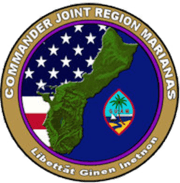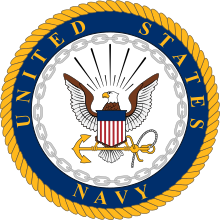Joint Region Marianas
Joint Region Marianas (JRM) is a joint United States military command located on Guam. It is the installation management authority for both Andersen Air Force Base (Andersen AFB) and Naval Base Guam (USNB Guam). Its headquarters is located halfway between the two installations, on Nimitz Hill. The command is an amalgamation of the United States Navy (USN) USNB Guam and the United States Air Force (USAF) Andersen AFB which were merged on October 1, 2009.[1]
| Commander, Joint Region Marianas U.S. Naval Forces Marianas | |
|---|---|
 Command insignia of Joint Region Marianas | |
| Active | 1999 - present |
| Country | |
| Branch | |
| Type | Region Command |
| Role | Support and control of U.S. Navy and U.S. Air Force personnel in the Marianas region |
| Part of | Naval Installations Command as Joint Region Marianas U.S. Pacific Fleet as Commander, U.S. Naval Forces Marianas |
| HQ | Nimitz Hill, Guam |
| Nickname(s) | JRM |
| Commanders | |
| Current commander | |
| Deputy Commander | |
History
JRM was established in accordance with congressional legislation implementing the recommendations of the 2005 Base Realignment and Closure Commission. The legislation ordered the consolidation of facilities which were adjoining, but separate military installations, into a single joint base, one of 12 formed in the United States as a result of the law.
On February 6, 2009, the Navy and Air Force held a groundbreaking ceremony for a combined headquarters at Nimitz Hill, signaling the beginning of Joint Region Marianas. Joint Region Marianas began initial operational capability on Jan. 31, 2009, and reached full operational capability on October 1, 2009.[1]
Under Joint Region Marianas, USNB Guam and Andersen AFB will each maintain commanding officers, who will oversee their respective mission requirements and operations. Joint Region Marianas will oversee support services, policies, and resources. Joint Region Marianas is symbolic of the historic partnership between the Navy and Air Force on Guam, bridging the approximately 30 miles between USNB Guam and Andersen AFB.[1]
The commander of Joint Region Marianas also serves as commander of U.S. Naval Forces Marianas and as U.S. Defense Representative to Guam, Commonwealth of the Northern Mariana Islands, Republic of Palau, and Federated States of Micronesia.[1]
Naval Base Guam
USNB Guam is home of Commander Submarine Squadron 15, Coast Guard Sector Guam and Naval Special Warfare Unit One and supports 28 other tenant commands. It is the home base of dozens of Pacific Command, United States Pacific Fleet, and Seventh Fleet units.
Submarine Squadron 15 consists of Los Angeles-class submarines USS Oklahoma City (SSN-723), USS Key West (SSN-722) and the submarine tender USS Frank Cable (AS-40).
Andersen Air Force Base
Andersen AFB is one of four bomber forward operating locations in the air force. These locations provide forward support to bomber crews deploying overseas in Europe, Southwest Asia and in the Pacific. The air force is establishing forward-deployed bomber beddown support at key locations throughout the world and Andersen is one of two critical bases in the Asia Pacific region. The other location is Diego Garcia in the Indian Ocean. Guam's almost unrestricted airspace and the close proximity of the Farallon de Medinilla Island, a naval bombing range approximately 150 miles (240 km) north, makes this an ideal training environment.
Units
Andersen is home to the following units:
References

External links
| Wikimedia Commons has media related to Joint Region Marianas. |
- Official Website
- Military: Naval Air Station, Agana (Tiyan) (closed). GlobalSecurity.org. Retrieved 2010-02-19.
- Official website



